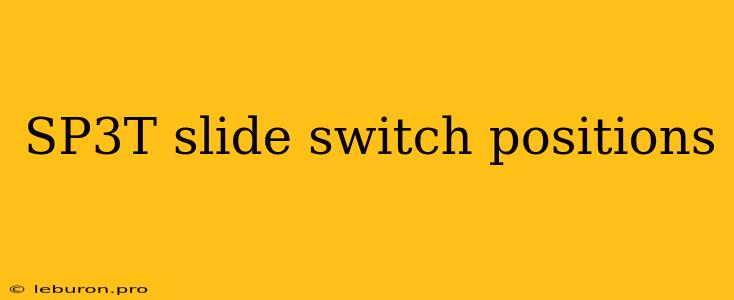Understanding SP3T Slide Switch Positions: A Comprehensive Guide
The SP3T slide switch, short for Single Pole, Triple Throw, is a versatile electrical component that allows for the selection of three different circuits with a single switch. This unique capability makes it ideal for a variety of applications, from simple electronics projects to complex industrial systems. However, understanding the different positions of the switch and how they affect the circuit can be challenging for beginners. This comprehensive guide aims to demystify the workings of SP3T slide switches, providing you with a clear understanding of their positions and their implications in circuit design.
The Basics of SP3T Slide Switches
Before diving into the positions, let's first establish the fundamental characteristics of an SP3T slide switch:
1. Single Pole: This refers to the switch having only one movable contact or "pole." This pole can connect to one of three fixed contacts or "throws" at any given time.
2. Triple Throw: This indicates that the switch offers three distinct paths or "throws" for the current to flow. The pole can be connected to any one of these throws, enabling you to control three different circuits with a single switch.
3. Slide Mechanism: The SP3T slide switch utilizes a sliding mechanism to move the pole between the three throws. This movement is typically achieved by a slider or lever, enabling you to switch between different circuit configurations easily.
SP3T Slide Switch Positions: A Detailed Analysis
Understanding the different positions of an SP3T slide switch is crucial for circuit design. Let's break down each position and its corresponding circuit configuration:
Position 1: Throw 1
- Circuit Connection: In this position, the movable pole is connected to the first throw contact. This configuration allows for the flow of current through the circuit connected to the first throw.
- Typical Applications: This position is often used to activate a primary function, such as turning on a device, activating a relay, or providing a signal to an external circuit.
Position 2: Throw 2
- Circuit Connection: Moving the slider to the second position connects the pole to the second throw contact. This enables the current to flow through the circuit connected to the second throw.
- Typical Applications: This position is commonly used for alternate functionalities, such as switching between different modes, activating a secondary function, or providing an alternative signal path.
Position 3: Throw 3
- Circuit Connection: The third position connects the pole to the third throw contact, facilitating current flow through the circuit associated with the third throw.
- Typical Applications: This position can be utilized for a variety of purposes, including disabling a circuit, providing a "ground" connection, or selecting an entirely different operational mode.
Visual Representation of SP3T Switch Positions
To further clarify the positions of the SP3T slide switch, let's consider a visual representation:
|--------|--------|
| Throw 1 | Throw 2 |
|--------|--------|
| | |
| Pole |
| | |
|--------|--------|
| Throw 3 |
|--------|--------|
In this diagram:
- The Throw 1, Throw 2, and Throw 3 represent the three fixed contacts.
- The Pole represents the movable contact that slides between the throws.
- The vertical lines indicate the possible positions of the pole, connecting it to different throws.
Understanding SP3T Slide Switch Symbolism
Electrical schematics use symbols to represent different components. The SP3T slide switch is depicted with a specific symbol:
_
/ \
| |
\___/
|
|
/ \
/ \
/ \
- The top part of the symbol represents the three throws (Throw 1, Throw 2, and Throw 3).
- The bottom part of the symbol represents the movable pole.
Practical Applications of SP3T Slide Switches
SP3T slide switches are widely used in various applications, including:
-
Electronics Projects: These switches are ideal for controlling different circuits in DIY projects, such as powering LEDs, switching between different audio sources, or controlling robotic movements.
-
Industrial Systems: SP3T switches are used in industrial automation for controlling motors, sensors, and other devices. They can also be used in safety systems, enabling manual override or emergency shutdown mechanisms.
-
Medical Devices: SP3T switches are employed in medical equipment to control functions, such as selecting treatment modes or adjusting settings.
-
Automotive Applications: These switches are used in vehicles for various functions, such as selecting different gear modes, activating wipers, or controlling lighting systems.
SP3T Slide Switch Selection: Key Considerations
When selecting an SP3T slide switch for a specific application, it's essential to consider the following factors:
-
Current Rating: The switch's current rating should be sufficient to handle the load in the circuit.
-
Voltage Rating: The voltage rating should exceed the maximum voltage the switch will encounter.
-
Switch Type: Choose a switch with the appropriate switching mechanism, such as a slide, rocker, or toggle switch.
-
Size and Mounting: Consider the size and mounting requirements to ensure a suitable fit for the application.
-
Durability: Select a switch with a durable construction and suitable environmental ratings for the intended environment.
Conclusion
The SP3T slide switch is a versatile and powerful component that offers a convenient way to control multiple circuits with a single switch. Understanding the different positions and their corresponding circuit connections is essential for effectively utilizing this switch in your projects. By applying the knowledge gained from this guide, you can confidently incorporate SP3T slide switches into your designs, enhancing functionality and versatility in your circuits.
